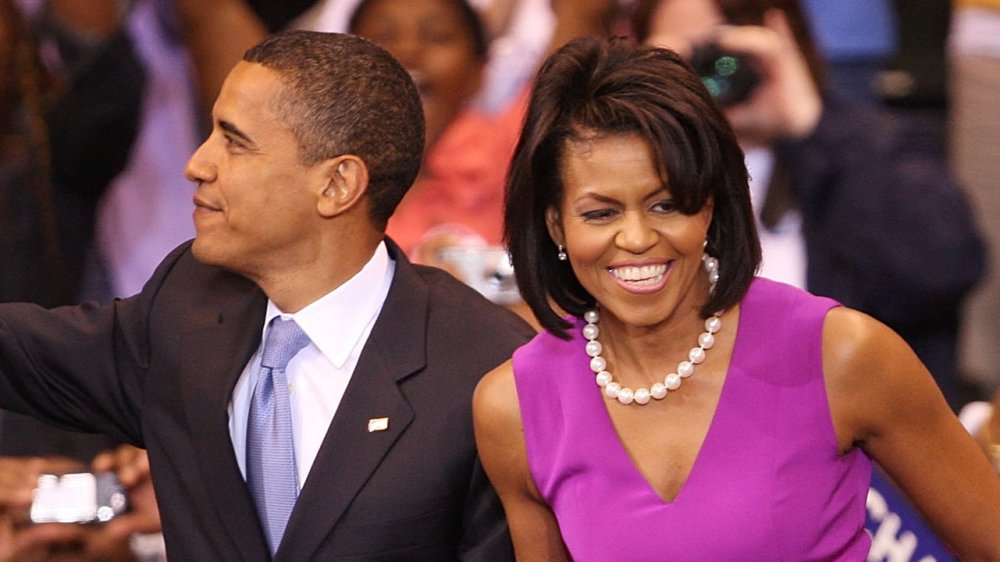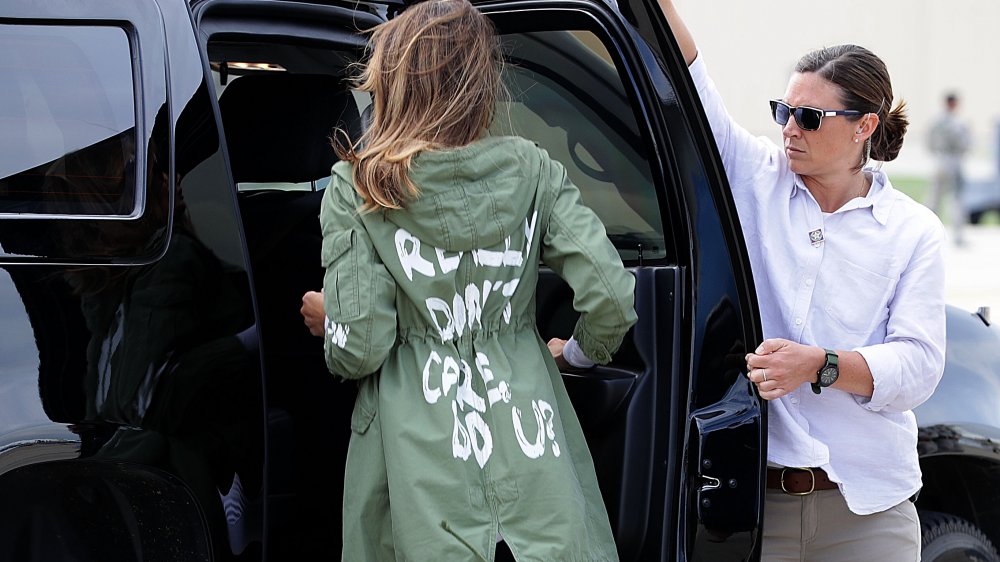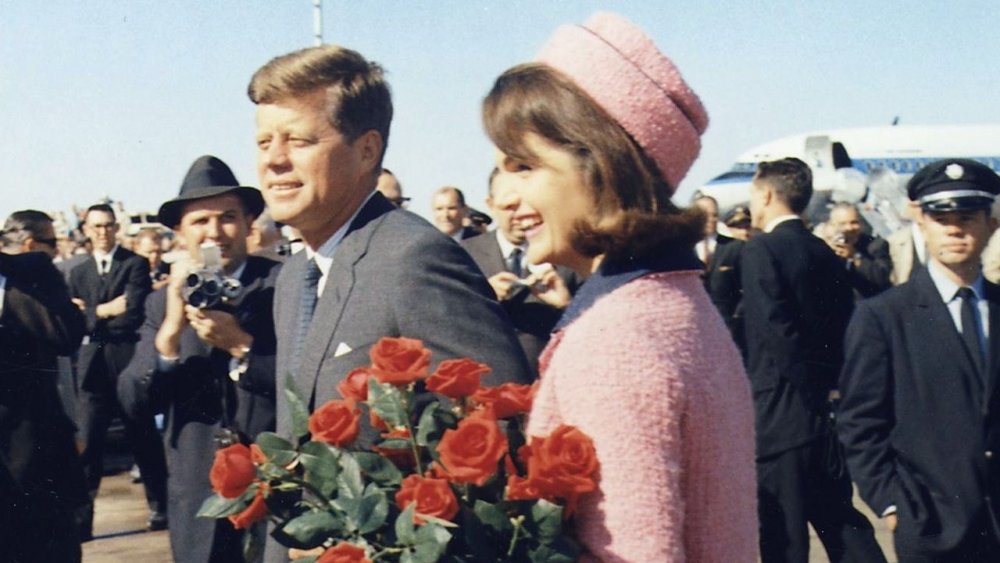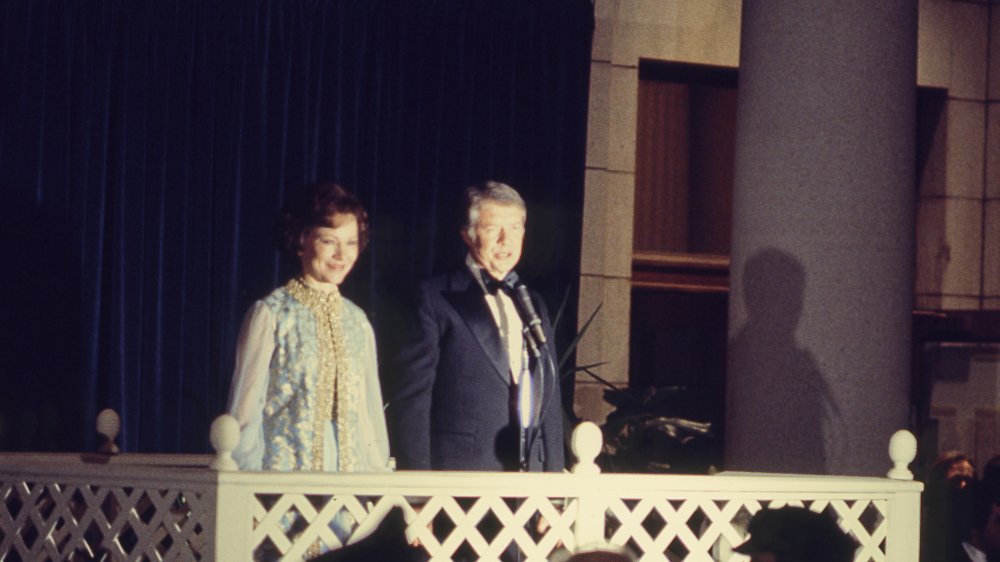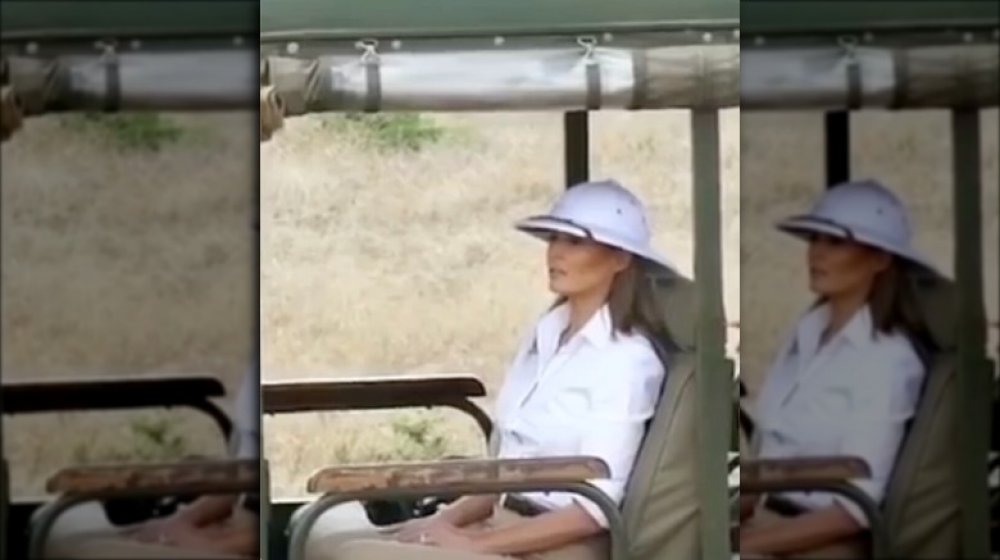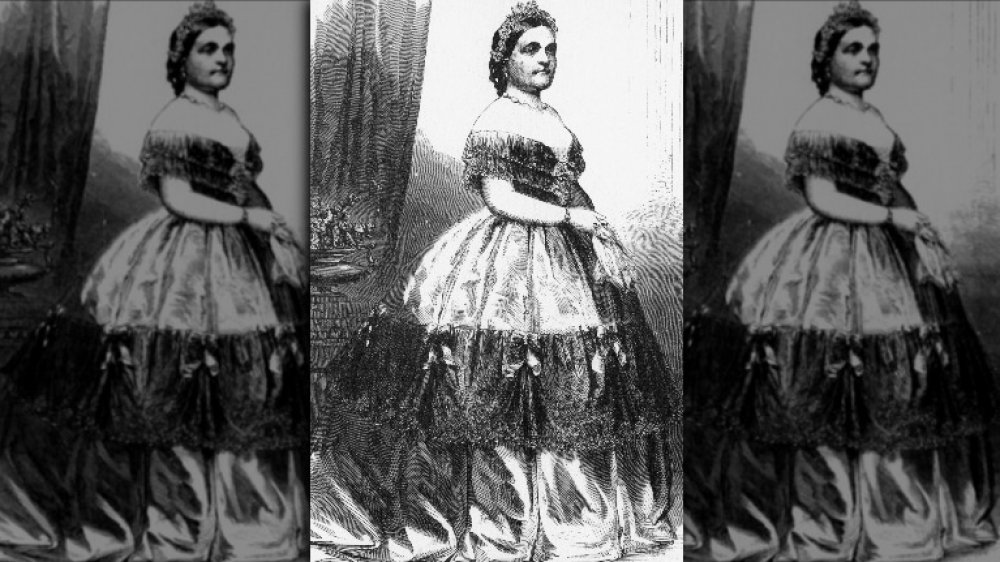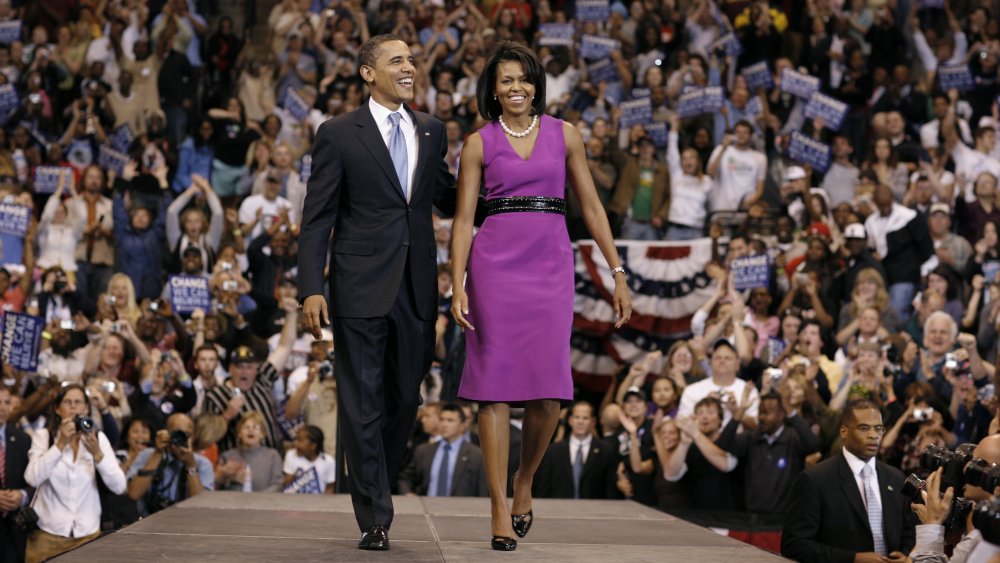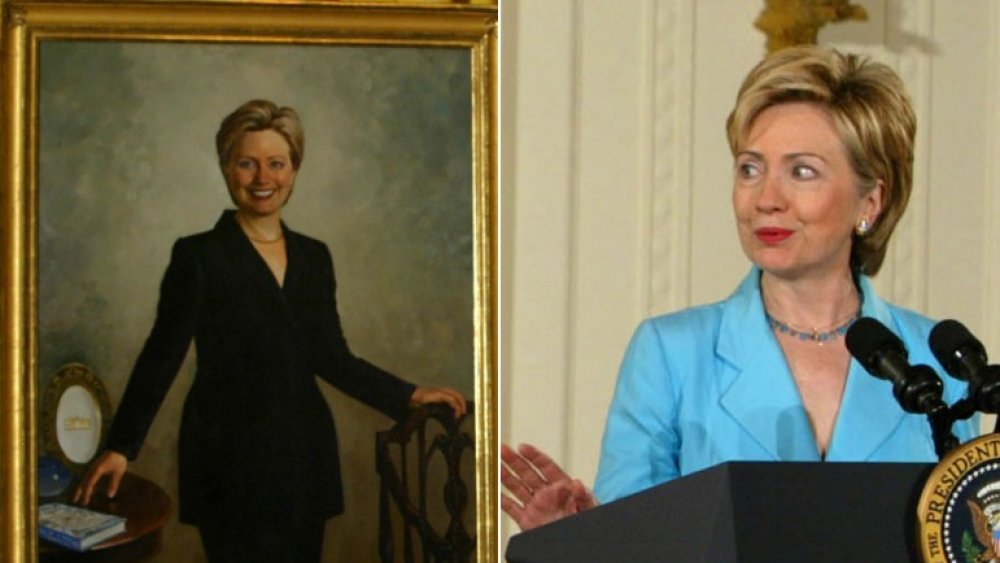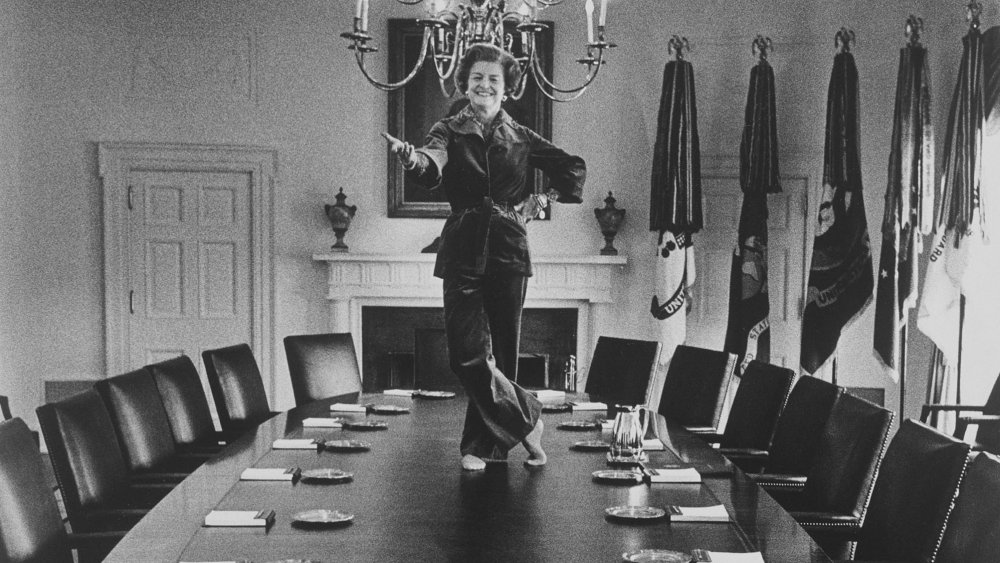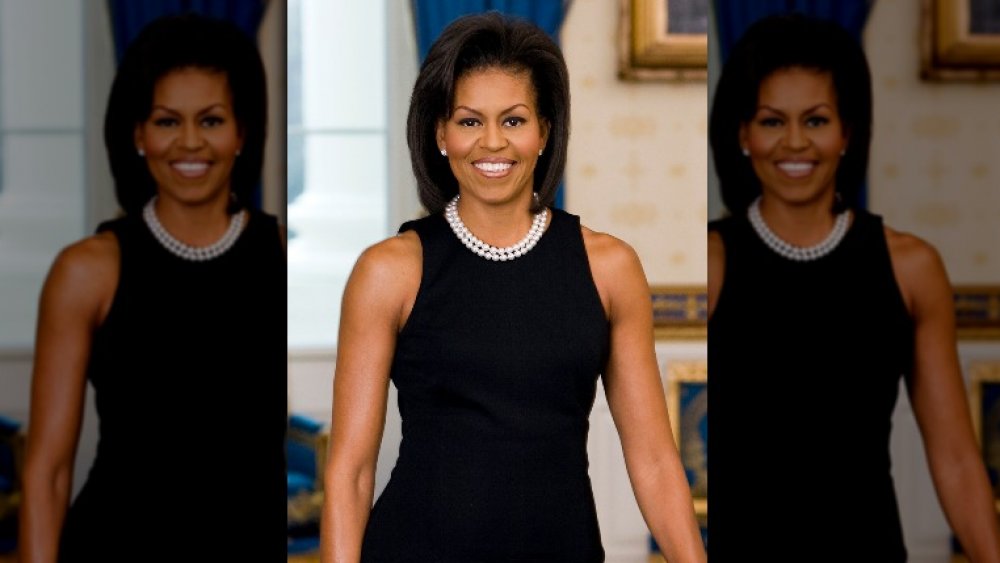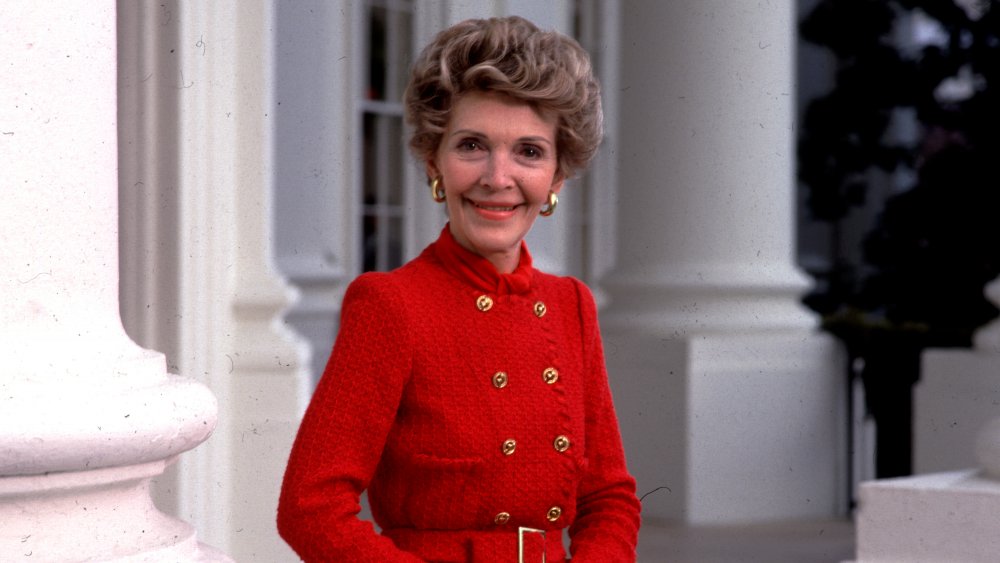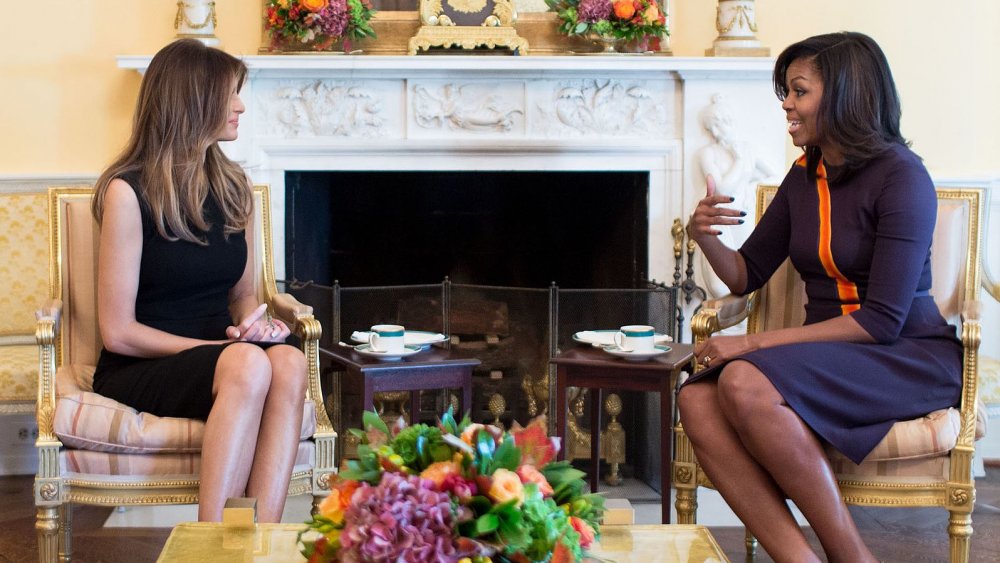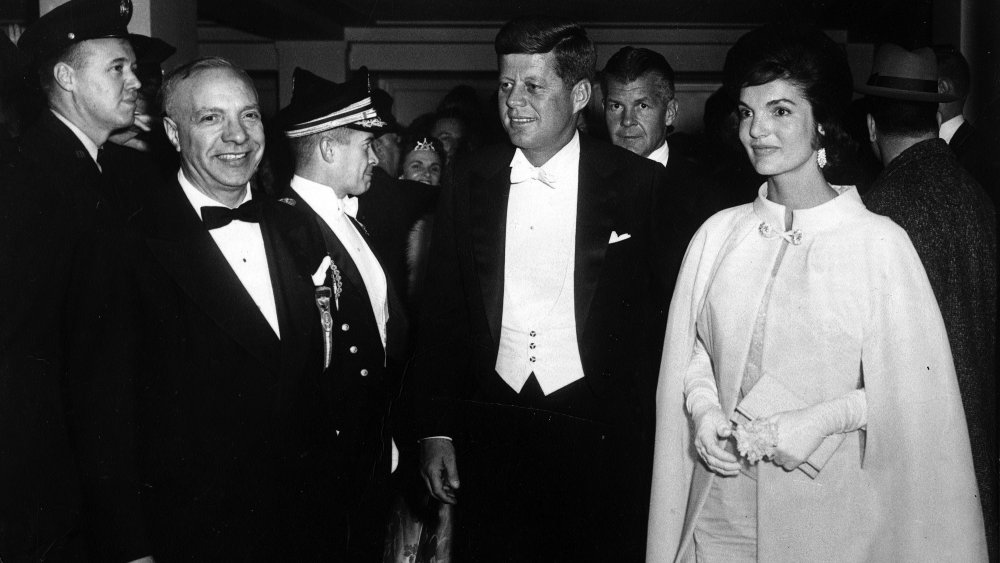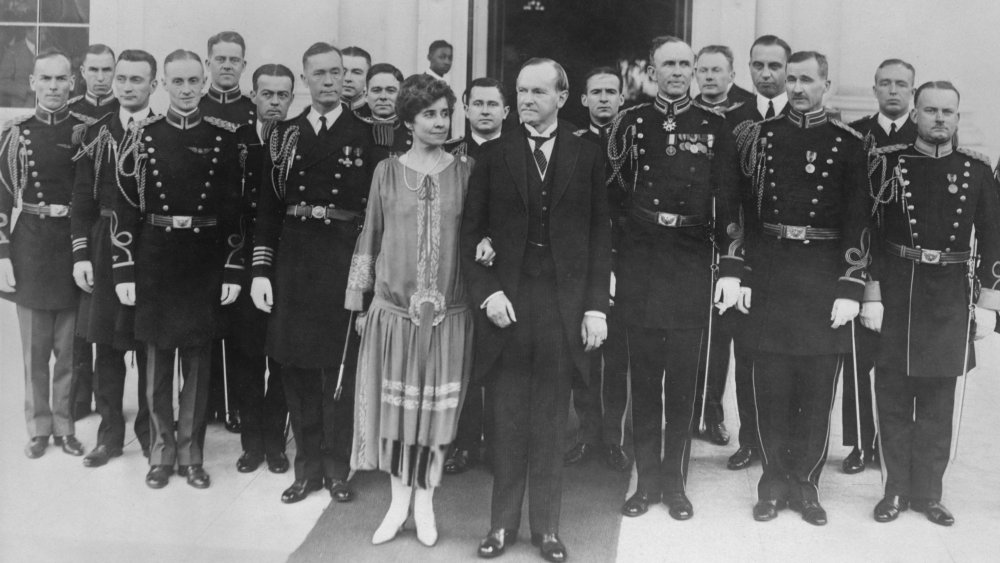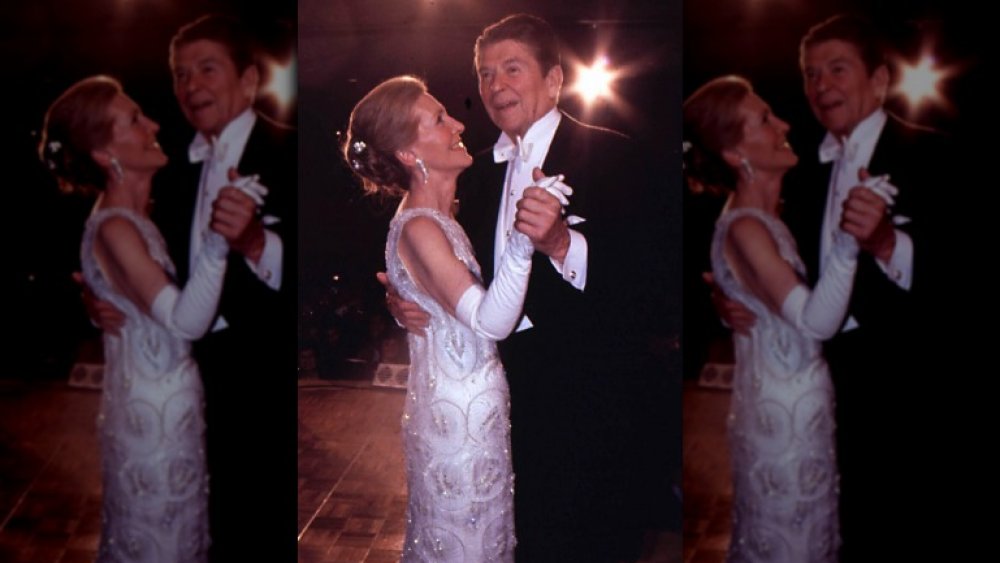The Most Impactful First Lady Fashion Moments In History
Just as powerful as speeches, appearances, and interviews are the fashion choices of a United States First Lady. The role's rich history has not only solidified women as style icons, but has served as a reflection of the country and the values of the presidency.
Some of America's First Ladies have cemented their status with fashion choices. Jackie Kennedy, for instance, is still the First Lady to beat in terms of elegance, fashion sense, and grace. Nancy Reagan coined a statement color within her wardrobe, ultimately impacting the future of her political party, and Michelle Obama used designers to pay homage to visiting dignitaries and White House guests.
Have you ever wondered what outfits have been political scene stealers? What did First Ladies like Mary Todd Lincoln, Betty Ford, or Rosalynn Carter wear? The fashion moments within a First Lady's time in the White House will stand the test of time, so we scoured through the history books and compiled the most impactful fashion moments in First Lady history.
First Lady Melania Trump's I really don't care jacket made a splash
First Lady Melania Trump came to the White House with a rich fashion history. A former model and fashion icon, she was no stranger to stilettos and photographers, but her fashion choice when heading to a child immigrant detention center in 2018 was bold and, to some, offensive. After choosing to wear a rain jacket from Zara with the words "I really don't care, do u?" splashed across the back in striking white letters, Trump was the subject of intense media scrutiny and was accused of sending a hurtful message. And it went down as one of the most inappropriate outfits worn by presidential family members.
"It's a jacket. There was no hidden message," Trump's communications director Stephanie Grisham told NPR. "After today's important visit to Texas, I hope the media isn't going to choose to focus on her wardrobe."
But the alleged meaning of the jacket quickly changed when President Donald Trump tweeted that the jacket's words were in reference to the First Lady's distrust of the media, a message that she then buckled down on in an October interview with ABC News. Whether there was an intentional message behind the fashion choice or not, it certainly made headlines.
First Lady Jackie Kennedy's pink skirt suit stands as a reminder of a dark day
When Jackie Kennedy wore a pink Chanel skirt suit and pillbox hat, the world didn't know how monumental her outfit choice would become. The day was Nov. 22, 1963, and she and her husband, President John F. Kennedy, arrived in Dallas, Texas to continue campaigning for his reelection.
But the day resulted in Kennedy's assassination, as he was shot in the back while riding in an open-air car. The First Lady's suit became a symbol of the assassination, as she kept it on (despite the blood stains) for hours after the attack. "Let them see what they've done," she said, as noted by Marie Claire.
The suit was eventually sent to The National Archives as a historical gift, and it is preserved at the National Archives Building in Maryland. As per the contract, the clothing items from that day are never to be publicly displayed or used in any way that would "dishonor the memory of Mrs. Kennedy or President Kennedy, or cause any grief or suffering to members of their family." The suit remains one of the most recognized outfits of any First Lady, unfortunately tainted with a devastating history.
In a sustainable choice, First Lady Rosalynn Carter repurposed her dress for the inaugural ball
The inaugural ball, which takes place after a president is sworn into office, is a First Lady's first big opportunity to showcase her fashion sense to the country. Some First Ladies have used the cameras and the press coverage to set the tone of their style for the years to come, but others, like Rosalynn Carter, have utilized the evening to give the American people a sense of who they are.
Carter's decision to wear a blue chiffon dress accented with gold was a bold one — not because of the design or the material, but because she had worn the dress twice before. Lisa Kathleen Graddy, the curator of The Smithsonian Museum of American History's inaugural ball dress collection, told Time that Carter's choice was reflective of who she was as a First Lady and who her husband was as a president.
"It enhanced the incoming Carter presidency's notions of modesty and frugality," Graddy said. That despite critics calling it a squandered opportunity to showcase American designs, Carter remained true to her financially reserved beliefs.
During her visit to Africa, First Lady Melania Trump's outfit sparked outrage
First Ladies have been known to travel to foreign countries, often serving as representatives of the United States. And even internationally, their wardrobe choices receive a lot of attention. No example is more true to this than First Lady Melania Trump's 2018 trip to Africa, during which she was seen wearing a white pith helmet, as noted by USA Today.
The pith helmet gained notoriety after a 1902 book entitled Handbook for Travellers in India, Burma and Ceylon was published for Europeans. Its author, John Murray, insisted that pith helmets were necessary in keeping harsh sun rays away from Europeans' skin. As noted in The Washington Post, the notion was based on "racist pseudoscience," and the pith helmet continues to be a symbol of colonial era Europe.
Trump's choice to wear a fashion piece indicative of a racially charged past was not received well, and, when questioned, she said, as shared by The Washington Post, that she wished onlookers would "focus on what I do, not what I wear." But historian Matthew Carotenuto tweeted his dismay, writing, "Historical context matters."
Despite a nation in turmoil, First Lady Mary Todd Lincoln prioritized ball gown purchases
When Mary Todd Lincoln served as First Lady, the United States was going through unimaginable war and national strife. But that didn't stop her from indulging in extravagant dresses, most specifically her gowns inspired by Empress Eugénie of France, according to Time. Lincoln was only five feet tall, but her sense of style made her larger than life. She took inspiration from the popularized European cuts of the time, with many of her dresses boasting large skirts and low-cut necklines, and her personal seamstress Elizabeth Keckley made sure that her specifications were met.
Her husband, President Abraham Lincoln, was apparently not thrilled by his wife's dress choices and opulent spending, but she was adamant in her stylish ways. "The President glances at my rich dresses and is happy to believe that the few hundred dollars that I obtain from him supply all my wants," she's reported to have said. "I must dress in costly materials. The people scrutinize every article that I wear with critical curiosity."
First Lady Michelle Obama's powerful campaign trail fashion statement
When Michelle Obama came into the public eye during her husband's presidential campaign, she made it clear early on that she was ready for the work. And no other outfit of hers while on the trail emulated her sense of duty and commitment to the job than the sleeveless purple sheath dress that she wore to a campaign event in 2008. The $900 Maria Pinto dress, which emphasized her waist with a moderate black belt, was paired with bold pearls and a no-fuss hairstyle.
André Leon Talley, an editor-at-large for Vogue, told The New York Times that "the faux pearls, the A-line dresses, the Jackie flip are obviously all part of how her image strategy has evolved," saying that the subtle hints to the fashion statements of former First Ladies was as intentional as it was functional. Mikki Taylor, beauty director for Essence, elaborated on Obama's pearl choice as a symbolic example of who she was as a spouse and as a potential First Lady. "Those are not little Breakfast at Tiffany's pearls," Taylor said. "Those are large pearls. Those are pearls you have to deal with."
First Lady Hillary Clinton's pantsuit became a symbol for female political power
Hillary Clinton is known as many things: a United States Senator, a Secretary of State, the 2016 Democratic nominee for President. But she gained notoriety as First Lady when her husband, Bill Clinton, was in office. And unlike previous First Ladies who took a backseat to politics, Clinton was a part of the action, and her wardrobe was reflective of that. No ensemble was arguably more important than the black pantsuit Clinton chose to wear in her official White House portrait.
A venue where First Ladies had worn beautiful dresses and perfectly coordinated jewelry, Clinton chose a no-fuss pantsuit, indicative of her law education, experience, and independence from her husband's political career.
By the time she became the 2016 Democratic nominee for President of the United States, the pantsuit had become a symbol of her political determination. Many supporters took to wearing a similar ensemble while going to the polls, and the hashtag #PantsuitNation was born, as noted by CNN. To this day, Clinton's projection of the pantsuit onto the national stage stands for something much larger than herself: gender equality.
Before Hillary Clinton's pantsuit, First Lady Betty Ford rocked the look in an iconic photo
Roughly 20 years before Hillary Clinton rocked a pantsuit as First Lady, Betty Ford made an incredible choice that set her apart. First Lady in the 1970s, Ford was truly ahead of her time. She embraced the disco era, was known for her dancing, and wore a mood ring. She was in favor of abortion rights, a supporter of the Equal Rights Amendment, a cancer survivor, and a divorcee, as noted by the Miller Center.
Ford, in her identity, really rejected the prescribed gender roles of the time and forged a space for herself. So it should come as no surprise that her iconic fashion moment while in the White House was accompanied by bold behavior.
As seen in a now-famous photo, Ford made her way into the Cabinet Room in the White House, climbed up onto the table, and struck a pose in a black pantsuit and no shoes. As noted by Marie Claire, she was one of the first women to wear a pantsuit in the White House, a bold declaration at the time given that Congresswomen weren't allowed to wear pants in the Capitol building until the 1990s.
First Lady Michelle Obama's toned arms became a hot topic
The First Lady's official photograph after assuming the role can set the tone for her time in the White House. As First Lady, Melania Trump went with a black ensemble and a steely expression. First Lady Laura Bush often opted for a skirt suit in a soft color while in the role. But Michelle Obama's official photo drew strong responses due to her decision to show her arms.
As noted by ABC News, critics responded to the portrait, saying that her decision to go sleeveless was too "informal" for a First Lady. But Politico reporter Malika Henderson told ABC News that she wasn't surprised by Obama's choice. "She very much is her own person," Henderson said. "Her kind of philosophy of fashion is that women should wear what they are comfortable in."
In a column written by Maureen Dowd for The New York Times in March 2009, Dowd acknowledged that during the 2008 presidential campaign, some saw Obama's sleeveless dresses and toned muscles as "daunting," but she was glad that the First Lady had ignored critics. "Michelle has soared every day, expanding the job to show us what can be accomplished by a generous spirit, a confident nature and a well-disciplined body," she wrote.
First Lady Nancy Reagan coined a simple silhouette and a signature color
First Ladies are hailed for their fashion choices, but Nancy Reagan took her love of simplicity and color to the next level. She discovered that red was her color, and her decision to wear it often coined the term "Reagan Red." When asked about her affinity towards red by W Magazine (as noted by NBC's Today), she said she'd always liked it as a fashion choice. "I always liked red. It's a picker-upper. I didn't give it the name of Reagan Red, but that became its name," she said.
Reagan wore red often, but the most notable time she donned the shade was for the now-famous photo taken of her at the White House. Her structured red dress, accompanied with a belt and gold details, is testament to her memorable fashion sense.
Her affinity for red even launched itself into the political arena, as red was not a symbol of the Republican party (of which her husband was representative of) until the late 1980s, as noted by The New York Times. It is possible that the First Lady's fashion choice attached itself to her party and to her husband's presidency.
During the White House transition, First Lady Michelle Obama wore unifying purple
Eyes were glued to the news when the Trumps took over the White House from the Obamas, and the fashion choices that the outgoing First Lady, Michelle Obama, made were on full display. Most notably, her Narciso Rodriguez dress that she wore when meeting with Melania Trump was symbolic in color and in its designer.
As noted in Vogue, the deep purple color of Obama's ensemble was similar to the suit that Hillary Clinton had worn while giving her concession speech. Glamour noted at the time that while purple is a color associated with grieving, it is also the result of mixing red and blue, and could have been Obama's way of bringing bipartisanship to the table. Purple was also used by the United States suffragists while fighting for the right to vote.
While we may never know the true intention behind the color choice, Obama's purple dress became symbolic during the time of transition. The First Lady was known for her intentional designer picks, and this dress was no exception. Designed by Rodriguez, a child of immigrants, it was speculated that the choice was a nod to her support of the immigrant community, according to HelloGiggles.
Jackie Kennedy started her First Lady fashion choices off strong at the inaugural ball
When we think of iconic First Ladies whose fashion choices have stood the test of time, Jackie Kennedy is high on the list, if not at the top. A trailblazer in her own right, Kennedy embodied sophistication and glamour during her time in the White House, and she started her role as First Lady on a strong note.
While attending the 1961 inaugural ball, Kennedy opted for an off-white silk chiffon gown, paired with a matching cape, gloves, and small purse. The dress consisted of a strapless bodice and peau d'ange skirt, and the new First Lady adorned her look with a classic up-do and drop earrings. She and her husband were the epitome of elegance while photographed at the ball, marking a new era of First Lady fashion.
At the time of the inauguration, The Washington Post, as noted by the National Museum of American History, published a description of Kennedy's ensemble along with a glowing review, calling her choice an impressive start to a "career as a major fashion influence."
First Lady Grace Coolidge was the epitome of 1920s flapper fashion
When we think of the 1920s, we think of Gatsby, flappers, and jazz. And while the era may not have been as glamorous as F. Scott Fitzgerald portrayed, Grace Coolidge embraced the flapper style and defined herself as a fashion-forward First Lady. Two of her dresses, which were gifted to her White House maid, serve as examples of the First Lady's fashion moments in an era that most of us would opt to return to only for the clothes.
Her brown lace and chiffon flapper dress, accessorized by a velvet bow adorned at the hip and metallic thread accents, fits right into the glamorous era that was the pre-Depression 1920s. Coolidge's evening gown, a blue satin dress decked out with beads, sequins, and intricately designed accents, was also downright beautiful.
As noted by the National Museum of American History, women of the time looked to Coolidge as a fashion example, as she mixed First Lady modesty with the frills and fun of the time. According to the museum, Coolidge was also a fan of shopping, and her husband often picked out hats and dresses for her too. When someone figures out that time machine, let us know!
First Lady Nancy Reagan's inaugural ball dress put this designer on the map
First Lady Nancy Reagan's 1981 inaugural ball gown not only solidified her style, but it also launched the career of designer James Galanos. While she had known the designer since the 1950s, her First Lady fashion choices were often associated with Galanos, and all eyes were on her stunning inaugural dress.
The Galanos creation was both 1980s-inspired and timeless. The white, one-shouldered dress adorned with an intricate beaded pattern was a standout. Reagan returned to Galanos for her second inaugural dress in 1985, and the dress was just as much of a knock-out as the first. But despite their close relationship, Galanos remained secretive of their bond. After his death, his niece told The New York Times that he was "like a vault," and never spoke of his time with Reagan.
"The only thing he said to me once was that she knew what worked for her, what looked good on her," Galanos's niece said. But as beautifully described in The New York Times, the most predominant example of Reagan's relationship with Galanos was in the clothes he designed for her that still speak to her elegance and sense of style to this day.
